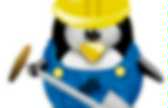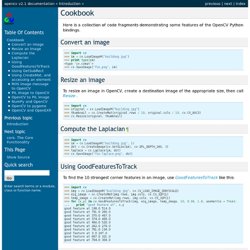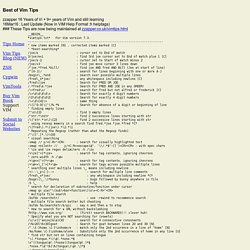

Cookbook. Here is a collection of code fragments demonstrating some features of the OpenCV Python bindings.

Convert an image >>> import cv >>> im = cv . LoadImageM ( "building.jpg" ) >>> print type ( im ) <type 'cv.cvmat'> >>> cv . SaveImage ( "foo.png" , im ) Resize an image To resize an image in OpenCV, create a destination image of the appropriate size, then call Resize . >>> import cv >>> original = cv . Compute the Laplacian >>> import cv >>> im = cv . Using GoodFeaturesToTrack To find the 10 strongest corner features in an image, use GoodFeaturesToTrack like this: >>> import cv >>> img = cv .
Using GetSubRect GetSubRect returns a rectangular part of another image. >>> import cv >>> img = cv . Using CreateMat, and accessing an element >>> import cv >>> mat = cv . PIL Image to OpenCV (For details on PIL see the PIL handbook .)
13051 from torquepowered.com. Create your own MMORPG in just 10 EASY steps!!! The Torque MMO Kit IDE features integrated file management, Python/TorqueScript editing, and automation for common tasks. In just 10 easy steps, you can create your very own MMORPG for both the Torque Game Engine and Torque Game Engine Advanced *wink* *wink* *nudge* *nudge* ;) Here's a preview of a (very early) build presented in tutorial form. 1. Once you have installed the Torque MMO Kit, there should be a "Torque MMO Kit IDE" in your start menu and desktop. 2. Tutorials - Introduction to GLSL Programming - OpenGL Shading Language. The GLSL,acronym of OpenGL Shading Language, forms part of the programming languages for the graphics card’s vertex and pixel processors, for the same reason as the HLSL of Direct3D or the Cg of nVidia.

The vertex and pixel processors are processing units, to be found in the GPU (Graphics Processing Unit), which act respectively on the vertices and the pixels. In order not to repeat what I have already said on the presentation of programmable shaders, please see part 3 of the tutorial on graphics controllers. To seriously approach the programming of vertex and pixel shaders in GLSL, it is strongly recommended to equip yourself with the Orange Book, the reference book as far as GLSL is concerned (de Randi Rost - ISBN: 0-321-19789-5): Fig. 1 - The reference book on the GLSL language For the suite of this tutorial, we will now avail ourselves of the Demoniak3D platform to integrate and test our vertex and pixel shaders written in GLSL. Before going further, let us clarify the vocabulary. Project Hosting on Google Code. Welcome.
Welcome home. Vimcmd.txt. Best of VIM Tips, gVIM's Key Features zzapper. Tips Home Vim Tips Blog (NEW) Cygwin VimTools Buy Vim Book Support VIM Submit to Social Websites.
